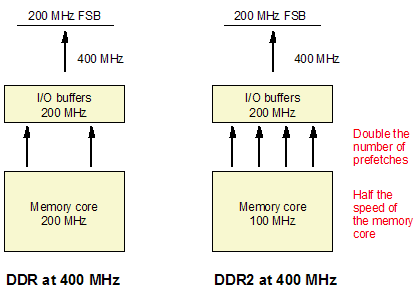Abstract
DDR2 is the name given to the latest memory technology used in IBM NetVista desktop PCs and IBM eServer xSeries servers. Based on SDRAM and DDR, it initially offers equivalent performance to DDR memory at lower power consumption. Further DDR2 offerings will be at higher frequencies, thereby offering greater throughput. This document describes the technical aspects of DDR2.
Main
Double data rate (DDR) memory techniques increase the data rate by transferring data on both the rising edge and the falling edge of the clock signal. DDR DIMMs use a “2x” prefetch scheme so that two sets of 64-bit data are referenced simultaneously. Logic on the DIMM implements multiplexing so that the two 64-bit results (plus ECC bits) appear on each of the rising and falling edges of the clock signal. Thus, two data transfers can be performed during one clock period.
DDR2 is the new generation of DDR technology. The primary benefit is the potential for faster throughput. Currently DDR2 operates at data transfer rates starting at 400 MHz (the upper limit for DDR) and 533 MHz. Support for 667 MHz and 800 MHz transfer rates is expected in 2005.
In addition, the DDR2 improves the power consumption of the DIMM because it works on a lower voltage. DDR operates at a range of 2.5 to 2.8 V, whereas DDR2 only requires 1.8 V. DDR2 consumes less power than DDR and offers a higher range of throughput because it has halved the speed of the memory core (thereby reducing power consumption), but offsetting that by doubling the number of prefetches from the memory core to the I/O buffers (from 2 to 4). This is shown in Figure 1 below.

Figure 1: Comparing DDR and DDR2 at the same external frequency
The lower frequency at the memory core means less power consumption and the ability to increase data density (and therefore capacity), and increase speeds as manufacturing technology improves.
The physical pin count of the DIMMs has also changed, meaning that the two standards are not compatible. DDR has 184 pins and DDR2 has 240.
The following table shows the specifications of the current DDR and DDR2 DIMMs.
| Type | Name | Bus speed | DDR transfers | Peak throughput |
| DDR | PC1600 (PC200) | 100 MHz | 200 MHz | 1.6 GBps |
| DDR | PC2100 (PC266) | 133 MHz | 266 MHz | 2.1 GBps |
| DDR | PC2700 (PC333) | 167 MHz | 333 MHz | 2.7 GBps |
| DDR | PC3200 (PC400) | 200 MHz | 400 MHz | 3.2 GBps |
| DDR2 | PC2-3200 | 200 MHz | 400 MHz | 3.2 GBps |
| DDR2 | PC2-4300 | 266 MHz | 533 MHz | 4.3 GBps |
| DDR2 | PC2-5300 | 333 MHz | 666 MHz | 5.2 GBps |
More detailed SDRAM specification information can be found at http://developer.intel.com/technology/memory/
As shown in the figure above, when comparing DDR and DDR2 at the same external frequency (400 MHz dual-edge), the throughput is the same. In addition, due to the internal core frequency of DDR2 being half that of DDR, there is more scope to increase frequencies and therefore increase the bandwidth of DDR2. However, the lower memory core frequency means longer latency time, the time it takes to set up the request for data transfer.
The end result of this is that at DDR2 lower frequency of 400 MHz, which is the DDR upper frequency, the two technologies offer equal throughput but DDR2’s latency is worse. However, as DDR2 increases in frequency (DDR has practically reached its limit), throughput will increase and latencies will equalize.
Trademarks
Lenovo and the Lenovo logo are trademarks or registered trademarks of Lenovo in the United States, other countries, or both. A current list of Lenovo trademarks is available on the Web at https://www.lenovo.com/us/en/legal/copytrade/.
The following terms are trademarks of Lenovo in the United States, other countries, or both:
Lenovo®
NetVista®
xSeries®
Other company, product, or service names may be trademarks or service marks of others.
